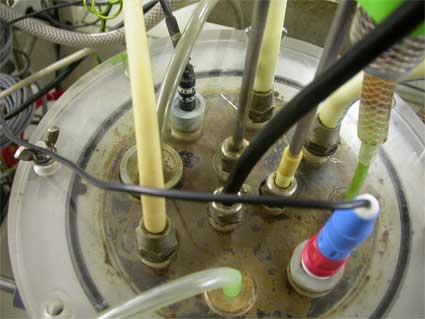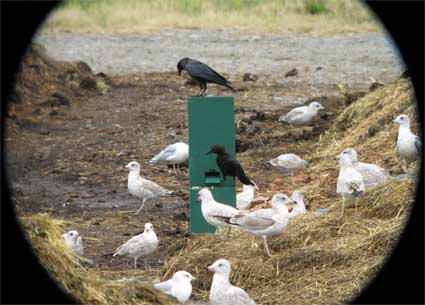The reason for my presence at etech08 this year was the “art fest” that i set up with the super nice and super smart Kati London, an itp graduate who currently works as a senior producer at area/code in New York and as an artist responsible for projects such as Botanicalls Twitter DIY and You Are Not Here.
Brady Forrest had the idea to organize this first ETech Emerging Arts Fest and we are infinitely grateful to him. We had our friendly debates and doubts but he is the first person who listened to our complains that artists should be given a voice in all those big technology conferences. The theme of the event was “Awareness” and we selected works that bridged the gap between perception and understanding. In retrospect i realize that Brady selected the geekiest pieces, Kati (who actually did most of the work) chose the playful ones and i went for information visualization.
Kati and i invited Brooke Singer to join us for a panel which attempted to illustrate the whole idea of awareness to the conference attendees. Because i’m never really interested in writing about my own presentations and because i’ve covered the work of Brooke several times (and will keep on doing so in the future), i’ll just focus on Kati’s talk.
She gave me the authorization to publish her slides so here they are:
And here the notes i took while she was talking:
She compared artists to hackers, they are the one giving the one finger salute to mainstream technology, they have ideas, go against the grain and keep on pushing their own inspiration forward no matter the resistance.
Today, we have more and more tools which empower people: OS hardware and software, library, there’s also a revival of the DIY culture, Arduino and Processing are increasingly successful, etc. Suddenly being creative with technology becomes possible for a larger number of people. How does this spirit translate when we think about “awareness”?
Kati then focused on several projects which, according to her, best embody the idea of awareness.
1. Invisible: Waste processes
drinkpeedrinkpeedrinkpee, by Rebecca Bray and Britta Riley, includes an installation and a diy kit for turning your pee into fertilizer for houseplants.

What happens when we think of our bodies as their own ecosystems? Are they open or closed ecosystems? Where do we draw the boundaries? Before we take medication, do we ask ourselves how it will affect our internal organs, our friendly bacteria? What is our medication’s future, beyond our bodies, in the sewage system and out in the waterways we swim in and eventually drink? What are the possible futures of our personal waste? What do sentient ecosystems eat and drink?
Human urine is actually sterile (unlike faeces, it is bacteria-free) and it can be a rich food source if it gets into the right part of the right ecosystem. Now, most human urine travels untreated into the waterways and is a significant cause of eutrophication, a toxic condition caused by harmful algae blooms, in the oceans. The excess nitrogen and phosphorus in our urine overfeeds algae and suffocates fish.
However, a biological waste treatment process developed at EAWAG Aquatic Research in Switzerland can extract this phosphorus & nitrogen for use as a fertilizer, leaving the rest of urine almost harmless to aquatic life. This kit gives users the opportunity to replicate the technique at home and fertilize their plants with their own pee.
 Bioreactor to stabilize urine, photo Eawag
Bioreactor to stabilize urine, photo Eawag
The installation will be on view and the DIY kits will be available at the exhibition FEEDBACK at Eyebeam, March 13 – April 19, 2008.
2. Invisible: Animal Behavior Patterns
Joshua Klein built a vending machine that teaches crows to deposit coins in exchange for peanuts. Crows are surprisingly (for me) intelligent. Their brain/body weight ratios are similar to chimpanzees. Look at the image below, seagulls don’t get the vending machines but those smart little crows seem to understand that there’s something worth their attention there.

Once he has fine-tuned the vending machine training, his plan is to train crows for search and rescue, picking up trash, and other mutually beneficial tasks (via boing boing). The machine is only the first step in his quest for “interspecies harmony.”
3. Invisible: Social Connections
 Generative Social Networking, by Andrew Schneider and Christian Croft, uncovers the dark sides of social networks by exposing their vulnerability. The software uses bluesnarfing to open the mobile phonebooks of people using security loophole-laden Bluetooth devices. This phonebook data is then fed through the GSN System. Unbeknownst to the phone owner, the device betrays its list of phone numbers to a laptop. An Asterisk phone server will then generate a “conversation” with each number in the list. The first number on the list is called and receiver’s response recorded. The next number on the list is called, the first number’s initial response is played back to the new number, and the new number’s response to the old number’s prompt is recorded. This continues for however many phone numbers are in the contact list.
Generative Social Networking, by Andrew Schneider and Christian Croft, uncovers the dark sides of social networks by exposing their vulnerability. The software uses bluesnarfing to open the mobile phonebooks of people using security loophole-laden Bluetooth devices. This phonebook data is then fed through the GSN System. Unbeknownst to the phone owner, the device betrays its list of phone numbers to a laptop. An Asterisk phone server will then generate a “conversation” with each number in the list. The first number on the list is called and receiver’s response recorded. The next number on the list is called, the first number’s initial response is played back to the new number, and the new number’s response to the old number’s prompt is recorded. This continues for however many phone numbers are in the contact list.
More fun with the video.

